AI art. Some love it, some hate it. Whether you use an AI generator from text or from photo, it is super-easy to create a Picasso-like piece in a few seconds that otherwise would require years of practice. Understandably, that leads to a lot of debate, even more so when an AI-generated artwork wins a contest. So what do artists think of AI art? In this post, we are going to delve into what artists think about ‘AI art being their end’ and how they feel it affects their lives!
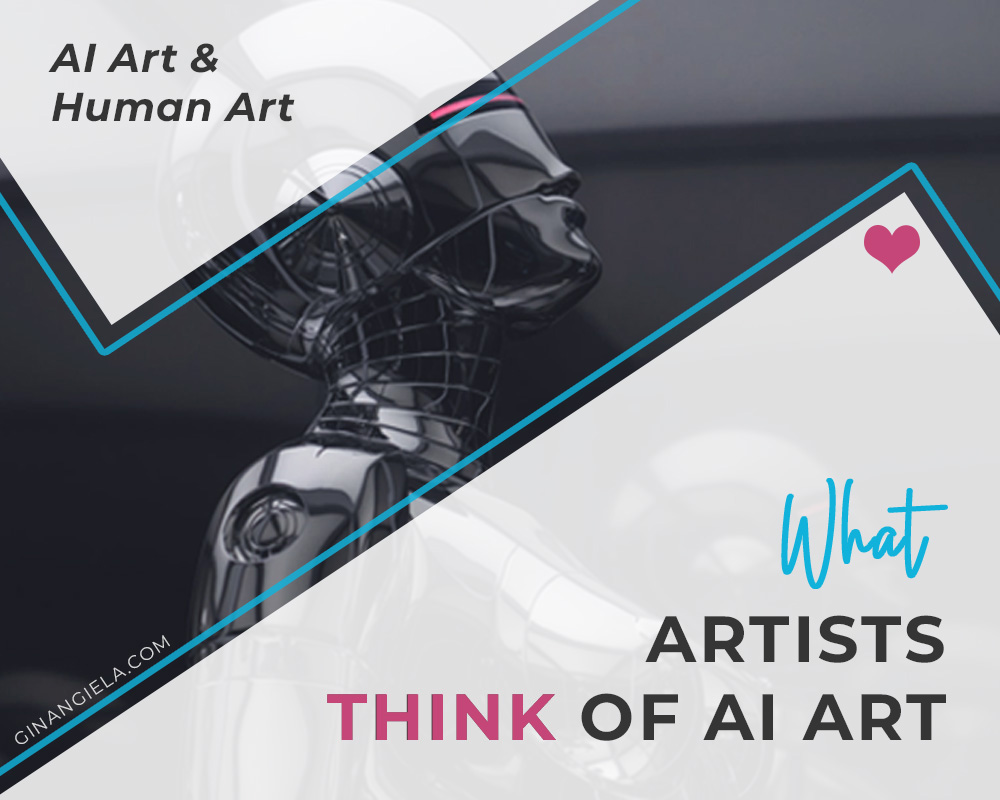
AI-generated art is the hippest thing around these days. On platforms like Midjourney, Stable Diffusion, DALL-E and Lensa, users create more than 20 million images EVERY SINGLE DAY. So it’s no wonder that these pieces are literally swamping the web!
So how do you create art with these programs? You enter a few text prompts describing the kind of image you have in mind and then artificial intelligence will produce some visual output based on your prompts. It is that simple. It is equally simple to recreate art in the style of the great masters like Picasso and van Gogh, and of any artist that ever lived.
Understandably, this leads to questions about the ethics and legitimacy of AI art, and the fate of human creatives. Some have accused AI art of stealing from artists and say that it is a threat to artists because it jeopardizes their livelihood.
As it stands, AI art is a huge topic and there’s lots of controversy going on. In previous posts, I already talked about whether AI art should be considered real art and explained why artists question that AI art is ethical.
In this post, we are going to delve into what artists think of AI art. Because they are the ones affected the most.
As a self-taught digital artist with more than a decade of experience, I have my own opinions about AI art. But I don’t want to make this all about me. That’s why I’ll be sharing the views of various artists and tech persons, and add my two cents here and there.
I encourage you to share your thoughts and feelings about AI art in the comments, so we can exchange our views and learn from each other!
That being said, let’s get the ball rolling. The entire AI art controversy actually flared up when an award-winning AI artist declared that artificial image generation is the end of art.
Is AI art the end of artists?
Recently, the AI Art vs. Human Art debate got heated up when an AI-generated artwork won a fine art competition in Colorado. Carrying off the first prize in the digital arts category, the winner declared:
“Art is dead, dude.”
Jason Allen, president of a gaming company, is the dude who used Midjourney to make “Théâtre D’Opéra Spatial” and ventured that opinion. Obviously, many artists were outraged at his comment.
I personally find it astonishing to hear such a statement from someone who considers himself to be an artist. Because who else if not an artist would submit their piece to a fine arts competition? So does Allen mean that ‘real art’ is dead? If so, then there is no more arguing that AI art should be considered ‘real art’. They must be two different things. Real art is dead. AI art is alive.
Or were Allen’s words supposed to imply that ‘all art’ is dead? In that case, AI art wouldn’t be art either because it’s not dead… Mmh. Very thought-provoking.
Or, might Allen just be expressing his disrespect for handmade artwork created by actual human beings? The good old art is dead because now everyone can be an artist by typing in a couple of prompts. But then again, that couldn’t be considered art, because ‘art is dead’…
Jokes apart, AI art does affect artists, and many are pretty worried.
“I’m very concerned about it,” says Greg Rutkowski, a Polish fantasy painter and gaming illustrator. “As a digital artist, or any artist, in this era, we’re focused on being recognized on the internet. Right now, when you type in my name, you see more work from the AI than work that I have done myself, which is terrifying for me. How long till the AI floods my results and is indistinguishable from my works?”
In fact, Rutkowski’s art style has already been copied thousands of times since generative AI systems hit the market a couple of months ago. Users have included Rutkowski’s name in their prompts almost 100,000 times on Stable Diffusion to generate artwork in his style. That’s why Rutkowski compared AI art to stealing from artists: “We could say that, ethically, it’s stealing,” he observes.
RJ Palmer, a California-based movie and game concept artist, agrees that “this thing wants our jobs, it’s actively anti-artist.” Painter and illustrator Kelly McKernan adds: “I’m incredibly anxious for the future of my career, more than ever before. Further, I’m concerned for the future of human creativity.”
Are you worried about your creative future with all the machine-made imagery swallowing up the market?
Worry not, AI art is not better than human art, and you don’t have to stand back and watch all your hard work get lost in the flood of artificial mass production. You can do something about it. Start now and learn how to promote your art when AI is the end of artists (supposedly)!
AI generators create new art based on the database of images they’ve accumulated from all over the web. The artworks of both living and dead artists went into their datasets, otherwise they wouldn’t be able to replicate an abstract painting ‘in the style of Picasso’. Actually, they wouldn’t be able to create anything. Mind you, none of the artists whose work has been used was ever asked for their consent, nor do they receive any attribution or credit.
Derek Murphy, fantasy novelist with a PhD in literature, sees the only solution in “banning robots from encroaching on artists, which is uniquely different from all other things (like robots taking over the jobs of Amazon workers, which is happening as we speak) because art is special, and must be protected. It’s not just a skill-based occupation. It’s more than the sum of its parts.”
But not everybody shares the gloomy outlook that AI art is the end of artists.
Photographer Rob Reyes holds a much more relaxed view. He sees AI art as a tool, and not a threat. He is okay with it, “as long as it serves the purpose of setting an idea, or as a guide, and is not used to replace a ‘real, created photograph’.”
Irina Raicu, a digital artist using AI, compares the new form of generative art to the beginnings of photography. “When photography appeared in the 19th century, it wasn’t considered art because the machine was doing much of the work. But a century later, photography became an art genre and nowadays photographs are exhibited in cultural institutions and auctioned off at astronomical prices.”
My two cents on the matter? First of all, I don’t believe that AI art is the end of artists. But it can be a threat to artists, to a certain extent. Technology may either be a curse or a blessing, depending on how it is used. I agree with Reyes that AI art can help artists when it ‘serves as a guide’, inspiration, or assisting tool, but unfortunately, most people are not using it that way.
In the right hands, AI can be a tool to benefit all of us. But in the wrong hands, it can just rip off the hard work of artists and give users the false impression that they are now artists themselves.
AI art is virgin territory and we cannot tell where we're headed.
However, as AI seems to be here to stay, it is important that we use it responsibly. It’s important that we don’t play fast and loose with our all human artistic achievements. This includes the visual artworks from both past and present, but also the oeuvres of composers and writers. After all, AI is not only able to generate imagery, but also music and text.
Do we really need to see the x-thousandth fake of an AI-generated artwork in Picasso’s style? I don’t think so. It’s already getting old. The initial excitement is wearing off quickly. We are all getting more sensitive to discerning what is real art and what is artificial. Eventually, the artificial will just bore us, and we’ll start digging for the real thing. Real art that was created by actual humans.
And we will appreciate it even more. So in my opinion, art is not dead. Rather, it is just rising from the dead.
- Stay in touch!
Our Newsletter is packed with creative tips, free tutorials, art tool reviews, and looaads of inspiration!
What do artists think of the AI art theft issue?
Apart from the above point that AI art may be the end to artists, there is much more going on in the AI Art vs. Human Art controversy.
As I just mentioned the Picasso-like images flooding the web, we need to talk about the copyright issues around generative art. Image synthesis models like Midjourney and Stable Diffusion concede all proprietary rights to the promptor. So while you might think that there are no copyright concerns from that side, the last word is still not said in the copyright debate.
Only recently, an AI developer tried to obtain the copyright over the imagery his system produces. His claim got rejected by the US Copyright Office with the explanation that “human authorship is a prerequisite to copyright protection.” But that doesn’t mean the matter is resolved. Legally speaking, no one can claim the copyright on AI-generated art up to this point in time. You can read more about the copyright issues in my second post of this series.
And that’s not yet the end of the debate.
Artists have accused AI developers of art theft and copyright violation.
Artificial image generation systems are being trained using the work of real artists. To make it possible for AI systems to generate new pieces, billions of publicly available images must first be fed into the database. Those images are pulled from all over the web, including sites like DeviantArt, ArtStation, Getty Images, Pinterest, and many more.
Dozens of artists have spoken out about having their artwork taken without their consent. Some alleged that AI is stealing their art.
And that’s still not the end of the copyright debate. There are more reasons why artists have a bone to pick with AI art.
Because AI makes it so easy to copy any artist’s style, whether dead or alive, creatives see their particular style being ripped off and their livelihood jeopardized. In response, artist protection initiatives have been formed, lawyers have been hired, and efforts are made to bring the issue up to the White House Task Force for AI Policy. More on that in the third post of the series, Is AI Art Stealing From Artists?
“Many authors see this as a great advantage, because this harvesting process offers the possibility of manipulating falsely copyright-free solutions immediately, otherwise they would take days to arrive at the same place, or simply would never arrive”, says Jon Juárez, an artist who has worked with Square Enix and Microsoft.
“If a large company sees an image or an idea that can be useful to them, they just have to enter it into the system and obtain mimetic results in seconds, they will not need to pay the artist for that image. These platforms are washing machines of intellectual property.”
AI text-to-image generators make it incredibly easy to create new art in the style of any artist you can find out there. As their databases include a rich choice of all kinds of images you can possibly find on the web, all you need to do is write ‘in the style of [insert artist name]’ and you will receive an image in that artist’s particular style within a couple of seconds.
“Great artists steal” is a famous saying in the art world, but RJ Palmer points out that AI is not just about finding inspiration in the work of other artists. “This is directly stealing their essence in a way,” he warns. “Right now, if an artist wants to copy my style, they might spend a week trying to replicate it. With this machine, you can produce hundreds of them a week.”
Animator Janina Malinis also feels that using AI is unfair to real artists. “You spend years learning and honing your craft, but then someone else just types in a few words and can get the same (or better) results even without any prior training,” she says.
Other artists, however, are more relaxed about it. For example, Floris Didden, art director at Karakter, an Emmy-award winning studio that produced Game of Thrones, sees things differently. “The nature of art-generating AIs doesn’t bother me as much as it seems to bother many artists”, he says.
“We all look at each other’s work for inspiration on style, execution, ideas, subjects, etc., and mixing it with our own ideas in some way to hopefully create something that can stand on its own.”
Polish artist Mateusz Urbanowicz, on the other hand, sees a clear difference between humans borrowing from artistic styles and AI replicating them one-on-one. “If someone makes art based on my style, and makes a new piece, it’s their piece. It’s something they made. They learned from me as I learned from other artists,” he explains. “If you type in my name in a prompt to make a new piece of art, it’s forcing the AI to make art that I don’t want to make.”
I agree that we all learn from each other. Art ideas don’t come out of the blue.
We all draw inspiration from what surrounds us, whether we want it or not. We start by trying out different things and with time we develop a liking for a certain style of art.
Learning from copying art is still a taboo in the art world. But the truth is that we don’t just wake up one morning thinking: ‘Oh, now I know that I’m going to work in that style that has never existed before.’ Art-making is always a joint venture, if you will.
I myself learned from other artists. When you look through my portfolio, you’ll notice that my early works focused around photographs of myself and of nature. Over time, I gravitated more towards surreal artworks, still consisting of photos of myself, but with a more lowbrow-popsurrealist touch (more about my personal story of doing lowbrow art here).
As you gain more experience, you will discover things that you particularly enjoy and then add more of those to your art. That’s how you’ll eventually develop a unique art style.
This is the first popsurreal-ish work that I created back in 2012. ‘Wounded Vanity‘ was inspired by the works of Michel Tcherevkoff. You can learn more about my inspiration and the creative making of ‘Wounded Vanity’ here.
Is learning from other artists the same as AI art allowing you to imitate any artistic style you want?
Absolutely not. Copying art is basically a way to develop your artistic skillset. You need to analyze the techniques the other artist used, figure out the tools you need to achieve a similar result, and learn how to handle them. That learning process requires a lot of time and effort. It doesn’t happen overnight.
And unless you are working on becoming a real forger, your work will never look like an exact copy of another person’s work. Even if you haven’t perfected your unique style yet, every work you create, even those you ‘copy’, will always let your own voice shine through. Which is a good thing.
Last but not least, a human creative will always strive to become proficient at their preferred style of art. They will never attempt to copy as many styles as possible. With generative AI, however, that’s no problem.
How do I feel about that aspect of ‘AI stealing art’?
The short answer is: really uneasy. Artificial intelligence has been scraping billions and billions of images available on the internet. This does not only concern image sharing sites like DeviantArt, ArtStation, Getty Images, or Pinterest. Virtually everyone who has ever publicly uploaded a picture to Instagram, Facebook or their personal website can be sure that this image went into the database.
And no one is likely going to take it out of that database. There’s nothing we can do about it. “The genie’s out of the bottle,” as Karla Ortiz, illustrator and board member of the Concept Art Association (CAA), so adequately said.
“These companies have now set a precedent that you use everyone’s copyrighted and private data without anyone even opting in,” she says. Companies like Lensa say they are “bringing art to the masses,” Ortiz continues. “But really what they’re bringing is forgery, art theft and copying to the masses.”
“And now we are facing the same problem the music industry faced with websites like Napster, which was maybe made with good intentions or without thinking about the moral implications.” I can only agree with Mateusz Urbanowicz.
It’s like another technological novelty has been thrown in the market without considering the consequences.
I got no idea where AI takes us. All I know is that it won’t go away, and sooner or later we’ll be seeing it in other consumer-facing apps as well. And who knows, maybe even Photoshop is going integrate some AI art feature in the future…
All I can say is that we should deal with artificial intelligence in a responsible manner – not only with artificial image generators. The best we can make out of artificial image generation, in my opinion, is use it in an ethical way so that AI art can help us as artists.
Thanks for sticking around to the end! ♥‿♥ It’s really interesting to see all the different opinions. I tried to view the topic from a broad range of angles, and now I want to know what you are thinking of AI art! Please leave comments and questions below or reach out to me directly. I’d love to hear from you! Make sure to sign up for my email list below so you don’t miss out on new blog posts and other cool stuff. ♥
For more about the topic, check out more posts from my AI Art vs Human Art series:
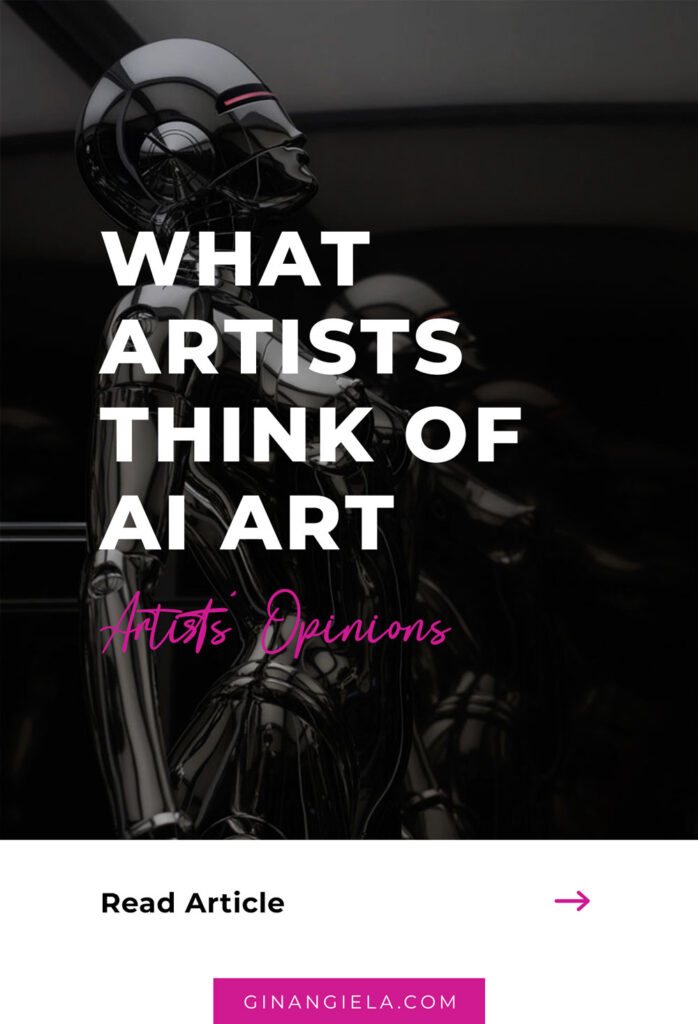




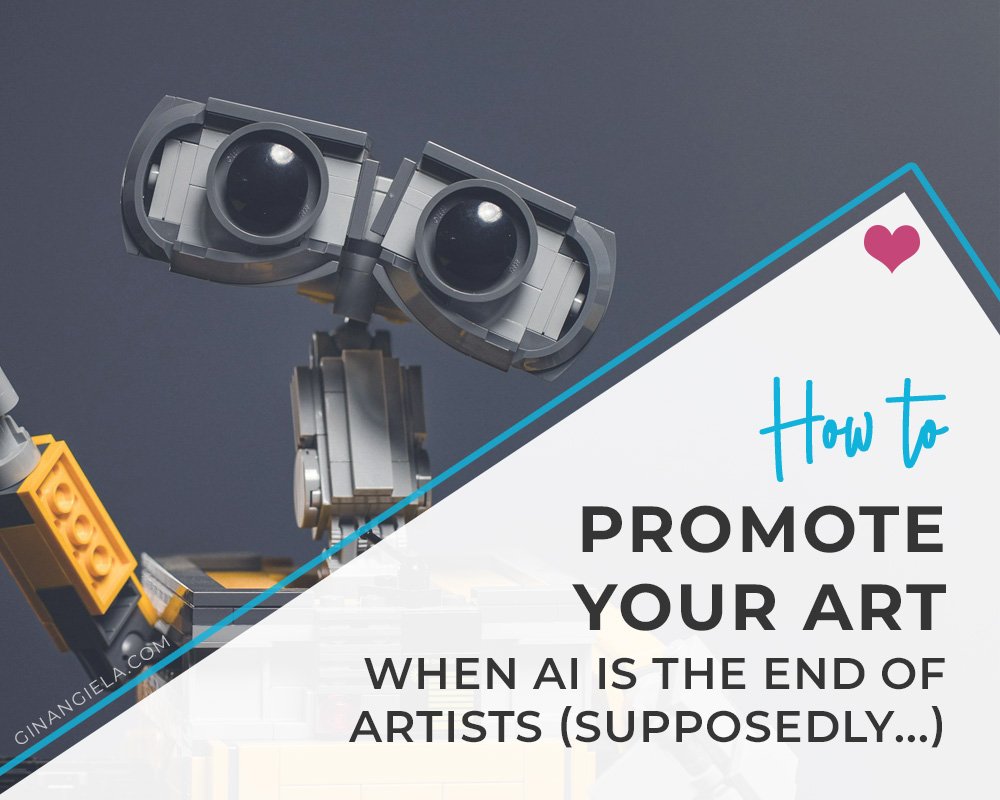

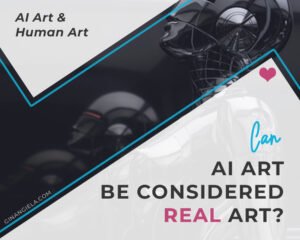
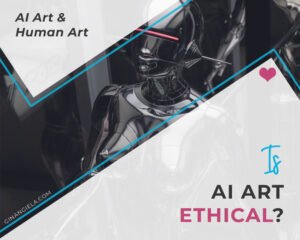
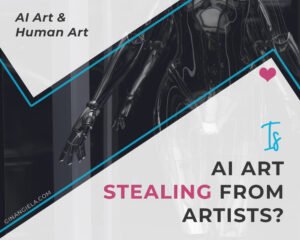
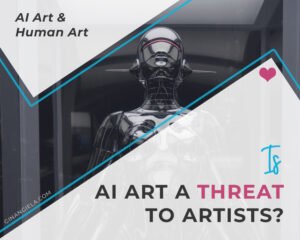
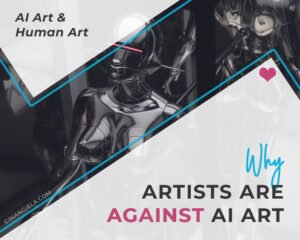

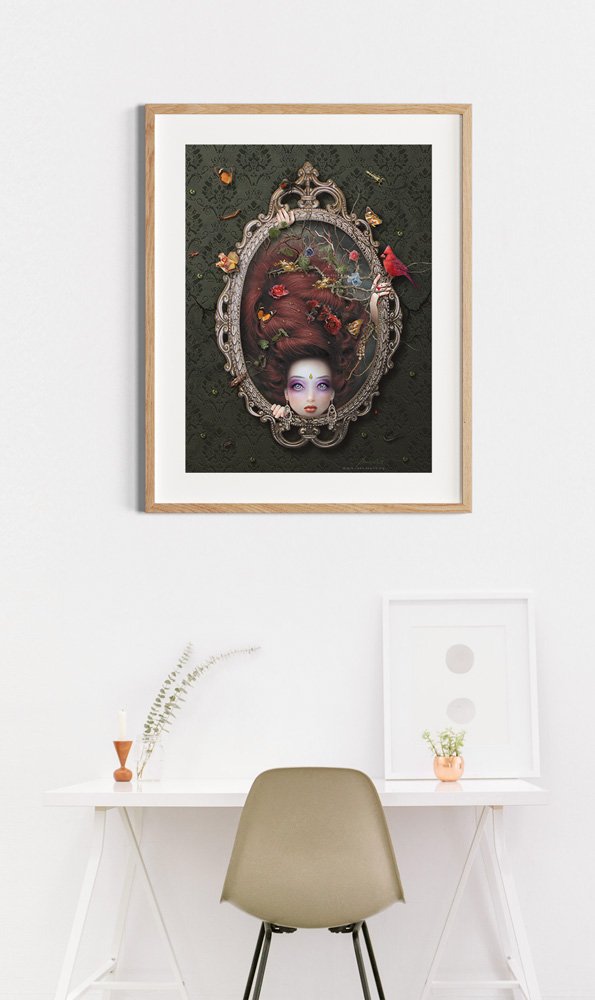
Thanks for bringing all these different opinions together, Angie. The debate on AI art raises questions about the role of the artist and the creative process. Can we consider the algorithm itself an artist, or is it merely a tool in the hands of a human creator? The intersection of technology and art requires us to reconsider the very definition of ‘real’ art.
I couldn’t agree more, Mary. The challenge of the 21st century is probably to find a new approach towards ‘real art’ as more and more image generators are being released almost by the day…